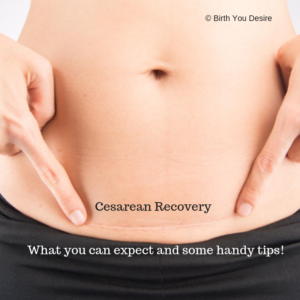What You Can Expect During Your Cesarean Recovery?
Recovery after a cesarean birth is different than vaginal birth recovery. Although the cesarean may have been necessary, it still is major abdominal surgery. You will need to limit your activities and follow your provider’s instructions fully. The recovery process after a cesarean usually takes 4-6 weeks and for some much longer.

Learn some great tips for your cesarean recovery!
Diet:
Your provider will recommend pain medication. Some women do well on just Motrin and others need opioids for a short period of time. Discuss your preferences with them as well as your medication history.
Ask your provider about taking a probiotic to assist with gut flora and healing. Also consider adding naturally fermented foods to your diet such as yogurt, kombucha, Keifer, and naturally picked vegetables like pickles and sauerkraut.
Hydrate continuously and urinate hourly. Adding fiber to your diet to help with constipation along with the stool softener they recommended. Papaya can be added to your daily diet as a natural way to regulate your bowels.
Activity:
Walking regularly is critical to healing and preventing blood clots immediately after birth. The movement also helps with constipation and general sluggishness. Short trips to the bathroom, kitchen, and walks outside near your house will make you feel better both mentally and physically. When sitting or lying for a long time, do ankle circles to prevent blood clots. And when you need to get up consider splinting your incision or holding a pillow to your incision when changing positions or coughing.
It is recommended not to lift anything heavier than your baby. Household activities like food shopping, cooking dinner, laundry, and heavy lifting should be avoided initially. Additionally, driving and putting the car seat in and out of the car are not recommended. Ask your provider what activities need to be limited or avoided.
Using a TENS unit on your incision after birth can help to minimize adhesions, increase mobility, and help your incision to lay flat. Start by placing the pads 2inches above the incision and running the unit for 20 minutes each day. At week two, move the pads closer to the incision and use the unit for 20-30 minutes. Eventually, place the pads next to the incision and use the unit for 20-30 minutes a day.
Breastfeeding:
Breastfeeding in the football and side-lye potions are usually preferred initially to avoid putting pressure on the incision site. As you heal, and the baby grows, you will move to more traditional positions as needed or desired.
Consider keeping things you need within arm’s reach. When food is nearby it is easier to stay fueled and hydrated. When the phone and remote are easy to access you can reach out as needed. Having a diaper changing station on each floor can help to minimize unnecessary bending and lifting.
Emotions:
Some people experience feelings of disappointment, sadness, and confusion about their cesarean. These emotions are normal but still need to be verbalized and acknowledged. Talk with your partner, provider, peers, and family about your experience. Some women and couples do best with talk therapy or professional processing. Consider asking your provider for a recommendation.
Limit visitors to those who are helpful and willing to assist you with household chores. Accept support, whenever it is offered, even when you don’t think you need it. There are lots of little tasks that can be done to help you to rest when the baby naps.
Exercise:
Do not perform any exercises until cleared by your healthcare provider. However gentle floor stretching should be fine. Most providers will also encourage a couple of flights of stairs and some short walks in the very beginning. When cleared to exercise, start back slowly and be gentle with yourself. Wear a belly binder to support your incisions and tissue as you start to exercise. Baby steps are the best steps to promote healing, and they may take much longer than expected.
Call your provider with any of the following:
- Any sign of infection such as bleeding, fluid, or discharge from the incision, separation of the incision, or a sudden change in redness, swelling, or tenderness of the incision.
- A fever over 100 degrees Fahrenheit
- A red, tender, or swollen area on your leg or arm, or if one leg is significantly more swollen than the other
- Sudden pain or new pain in the abdomen or breast that is getting more intense
